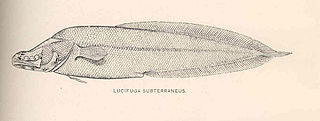Dinematichthys is a genus of viviparous brotulas. Its name comes from Greek, meaning two-filamented fish.

The viviparous brotulas form a family, the Bythitidae, of ophidiiform fishes. They are known as viviparous brotulas as they generally bear live young, although there are indications that some species do not. They are generally infrequently seen, somewhat tadpole-like in overall shape and mostly about 5–10 cm (2–4 in) in length, but some species grow far larger and may surpass 60 cm (2 ft).

Lucifuga is a genus of viviparous brotulas. Most of the species are native to caves and sinkholes in Cuba and the Bahamas; L. inopinata from deep water off the Galápagos Islands is the only exception. The four species rated by the IUCN are all considered vulnerable. The largest species in the genus reaches about 15 cm (5.9 in) in length.

Ogilbia is a genus of viviparous brotulas. The generic name honours the Australian naturalist James Douglas Ogilby (1853-1925), for his contribution to the knowledge of the fishes of Australia.
Alionematichthys is a genus of viviparous brotulas.
Beaglichthys is a genus of viviparous brotulas.
Dermatopsis is a genus of viviparous brotulas.
Diancistrus is a genus of viviparous brotulas.
Didymothallus is a genus of viviparous brotulas found in the Indian and western Pacific Oceans.
Dipulus is a genus of viviparous brotulas.
Eusurculus is a species of viviparous brotula.
Gunterichthys is a genus of viviparous brotula.
Majungaichthys is a genus of viviparous brotulas native to the western Indian Ocean. The generic name refers to Majunga in Madagascar where the type was collected.
Mascarenichthys is a genus of viviparous brotulas. They have mostly been collected from the region of Mascarene Plateau in the Indian Ocean and this is referred to in their generic name.
Ogilbichthys is a genus of viviparous brotulas found in the central-western Atlantic Ocean and the Caribbean Sea. he generic name refers to the resemblance of these fish to those in the genus Ogilbia, a name honours the Australian naturalist James Douglas Ogilby (1853-1925), combined with ichthys which means "fish" in Greek.
Paradiancistrus is a genus of viviparous brotulas.
Tuamotuichthys is a genus of viviparous brotulas found in the Pacific Ocean.
Ungusurculus is a genus of viviparous brotulas found in the western Pacific Ocean.
Bidenichthys beeblebroxi is a species of common reef fish of the family Bythitidae, and one of three species in the genus Bidenichthys. The species is found in the coastal waters off North Island and northern South Island, New Zealand. It is a common, uniformly gray-brown fish, ranging from SL 6.5–9.5 centimetres long in one study, found in holes beneath rocks and boulders in kelp forest and other reef habitats from the surface down to depths of 30 metres (98 ft). The species was described by Paulin in 1995.

Brosmophycinae is a subfamily of the viviparous brotulas. They are divided from the subfamily Bythitinae by having the dorsal fin, caudal fin and anal fin all separate whereas they are joined in the Bythitinae. It is divided into the tribes Dinematichthyini and Brosmophycini, with the first having hardened genital claspers and the second soft genital claspers. A review in 2016 elevated the Dinematichthyini to the status of a family the Dinematichthyidae.



